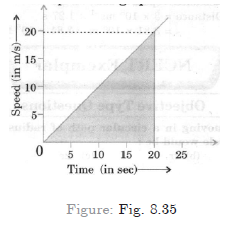Please refer to Motion Chapter 8 Class 9 Science Assignments below. We have provided important questions and answers for Motion which is an important chapter in Class 9 Science. Students should go through the notes and also learn the solved assignment with solved questions provided below. All examination and class tests questions are as per the latest syllabus and books issued by CBSE, NCERT, and KVS. We have also provided Class 9 Science Assignments for all chapters on our website.
Chapter 8 Motion Class 9 Science Assignments
Question. When is the acceleration of a body positive?
Answer
The acceleration of a body is taken to be positive if it is in the direction of velocity.
Question. What is the relationship between distance travelled and the time elapsed for the motion with uniform velocity?
Answer
Distance is directly proportional to time used.
In fact, distance travelled = Uniform velocity × Time used.
Question.Name the different types of graph.
Answer
Bar graphs, straight line graphs, histograms, etc.
Question. Which type of graph is used to describe motion?
Answer
Line graph are used to describe the motion of an object.
Question. Define the term velocity. What is its unit? Is it a scalar or vector quantity?
Answer
Velocity is a physical quantity that gives the speed and direction of motion of the body
Velocity = Displacement/ Time
The S.I. unit of velocity is ms–1. Velocity is a vector quantity because its description requires both magnitude and direction.
Question. Name the two types of physical quantities.
Answer
The two types of physical quantities are scalar quantity and vector quantity.
Question. What is the acceleration of a body moving uniform velocity?
Answer
The acceleration of a body moving with uniform velocity is zero.
Question. What is magnitude?
Answer
The numerical value of a physical quantity is called its magnitude.
Question. Define a scalar quantity.
Answer
A physical quantity which has only magnitude and no direction is called a scalar quantity.
Question. What is the difference between uniform linear motion and uniform circular motion?
Answer. When a body is moving with a uniform speed along a straight line, its motion is called linear uniform motion. The uniform linear motion is an accelerated motion.
When a body is moving with a constant speed along a circular path, the direction of motion of body changes continuously with time.
We know that a change in the direction of motion implies a change in velocity. Thus, uniform circular motion is an accelerated motion even though the speed of the body remains constant.
Question.Why is the motion in a circle at constant speed called accelerated motion?
Answer. When a body moves along a circular path with a constant speed, its direction of motion at any point is along the tangent to the circle at that point, this motion called accelerated motion. The direction of motion changes as the body moves in a circle and causes a change in the velocity. Therefore, the motion of an object along a circular path is an accelerated motion.
Question.What do graphs provide?
Answer. The graphs provide a convenient method to present pictorially the basic information about a variety of events such as motion.
Question.Give an example of use of bar graph and straight graph.
Answer. In telecast of one-day cricket match on T.V. vertical bar graphs show the run rate of a team in over. Straight line graph helps in solving linear equation in two variables.
Question.When do we say that the position of body has changed?
Answer.If the distance, or direction, or both of a body relative to a reference point changes then we say that the position of the body has changed.
Question.Classify the following as scalar and vector quantities :
Mass, weight, time, temperature, volumes, velocity, speed, forces, acceleration.
Answer.

Question.Define uniform acceleration. Give one example.
Answer. Uniform acceleration : An object has a uniform acceleration if it travels in a straight line and its velocity increases or decreases by equal amounts in equal intervals of time.
For example : The motion of a freely falling body has uniform acceleration.
Question.In a long distance race, the athletes were expected to take four rounds of the track such that the line of finish was same as the track was 200 m.
(i) What is the total distance to be covered by the athletes?
(ii) What is the displacement of the athletes when they touch the finish line?
(iii) Is the motion of the athletes uniform or nonuniform?
(iv) Is the distance moved by and displacement of athletes at the end of the race equal?
Answer.
(i) Total distance covered by the athletes = 4 × 200 = 800 m.
(ii) The line of start and the line of finish are the same so, Displacement = 0
(iii) The motion of the athletes is non-uniform.
(iv) The distance and displacement of an athlete at the end of the race are not equal.
Question.(i) Give an example of a body which may appear to be moving for one person and stationary for the other.
(ii) What can we tell about motion from the above example?
Answer.
(i) The man standing on the roadside observe that a bus along with its passenger is moving.At the same time, a passenger sitting in the bus observes his fellow passenger to be at rest.
(ii) We can tell that motion is relative.
Question.How many different kinds of motion are there? Name them. Is there any motion which is a combination of two or more types of motion?
Answer.
(i) There are three kinds of motion. These are :
(a) Linear or translatory motion.
(b) Circular or rotational motion.
(c) Vibratory or oscillatory motion.
(ii) Complex motion means a combination of two or more types of motions.
Question.What is motion? Give some examples of directly perceivable motion in daily life.
Answer.
(i) A body is said to be in motion if it changes its position in relation to a reference point (origin).
(ii) Some examples of directly perceivable motion in daily life are :
(a) Birds and animals moving from one place to another.
(b) Cars moving on the roads.
(c) Aeroplanes flying in the sky.
(d) Blades of a moving fan.
(e) Fish swimming in water.
Question. Find the distance covered by a particle during the time interval t = 0 to t = 20 s for which the speedtime graph is shown in figure.

Answer.
The distance covered in the time interval 0 to 20 s is equal to the area of the shaded triangle. So,
Distance = 1/2 × base × height
= 1/2 × (20 s) x (20 m/s)
= 200 m.
Question. A bus moves 30 km in 30 min and the next 30 km. in 40 min. Calculate the average speed for the entire journey.
Answer.
Given, the total time taken is 30 min + 40 min = 70
min and the total distance travelled is 30 km + 30 km
= 60 km
The average speed is

Question. A girl runs for 10 min at a uniform speed of 9 km/h. What should be the speed that she runs for the next 20 min, so that the average speed comes to 12 km/h?
Answer.
Total time = 10 min 20 min = 30 min
The average speed is 12 km/h using s = vt, the distance covered in 30 min is

Thus, he has to cover 6 km – 1.5 km = 4.5 km in the next 20 min.
The speed required is

Question. It is estimated that the radio signal takes 1.27 seconds to reach the Earth from the surface of the Moon.Calculate the distance of the Moon from the Earth.
Speed of radio signal = 3 × 108 ms–1 (speed of light in air).
Answer.
Here, time = 1.27 s
Speed = 3 × 108 ms–1
Distance = ?
Using distance = speed × time, we get
Distance = 3 × 108 ms–1 × 1.27 s
= 3.81 × 108 m = 3.81 × 105 km
Question. Divya walked 2 km on a straight road and then walked back 1 km. Which of the two quantities involved in her walking is greater- the scalar or vector?
Answer.
Distance travelled by Divya = 2 km + 1 km = 3 km
Displacement = 2 km – 1 km = 1 km
Hence, distance which is a scalar quantity is greater than the displacement which is a vector quantity.
Question. Two satellites A and B revolve around a planet C. The time taken by satellite B to go around the planet is twice the time taken by A. Which of the two satellites will have a greater magnitude of velocity?
Answer.
Satellite A will have greater magnitude of velocity since velocity is inversely proportional to time. (v = 2p r/t)
Question. A child moving on a circular track of radius 40 m completes one revolution in 5 minutes. What is his
(i) average speed (ii) average velocity in one full revolution?
Answer. Distance travelled in one revolution,2p r =2p × 40m
Displacement in one revolution = 0
Time taken = 5 minutes = 5 × 60s


